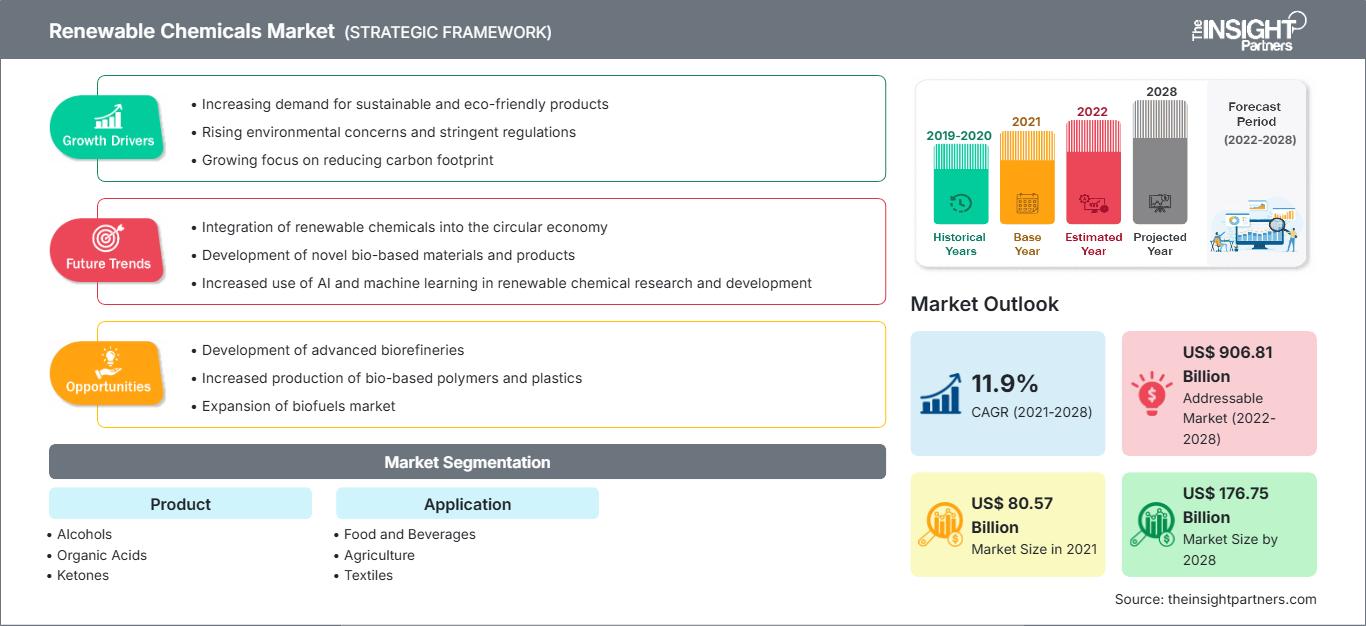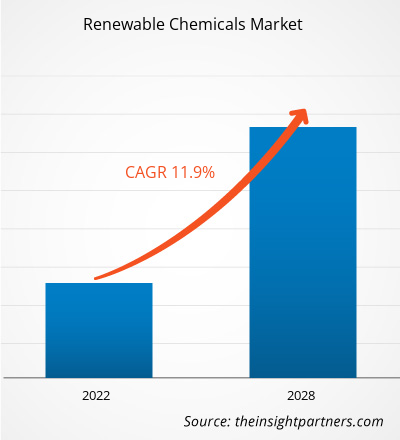Il mercato dei prodotti chimici rinnovabili è stato valutato a 80.566,30 milioni di dollari nel 2021 e si prevede una crescita a un CAGR dell'11,9% dal 2021 al 2028.
I prodotti chimici rinnovabili o prodotti chimici di origine biologica sono definiti come quelle categorie di prodotti chimici sintetizzati da fonti rinnovabili come materie prime agricole, rifiuti agricoli, prodotti di scarto organici, biomassa e microrganismi. I prodotti chimici rinnovabili sono classificati come prodotti chimici sostenibili ed ecocompatibili che emettono meno emissioni di carbonio rispetto ai tradizionali prodotti chimici a base di petrolio. Alcuni dei prodotti chimici rinnovabili più ampiamente disponibili sono lignina, carboidrati, oli, estratti vegetali, emicellulosa, cellulosa, amido, proteine e altri. Tali prodotti chimici trovano applicazione in diversi settori, come quello alimentare e delle bevande, agricolo, tessile, automobilistico, degli imballaggi e altri.
Nel 2021, il Nord America ha contribuito alla quota maggiore del mercato globale dei prodotti chimici rinnovabili. Il predominio del mercato dei prodotti chimici rinnovabili in questa regione è principalmente attribuibile alla presenza di una solida base industriale, con importanti aziende manifatturiere che contribuiscono in modo significativo alla crescita del mercato. L'elevata domanda di prodotti chimici rinnovabili da applicazioni quali alimentare e delle bevande, agricolo, tessile, trasporti, imballaggi e altri settori, sostenuta da una significativa crescita delle basi industriali di utilizzo finale, sta stimolando la domanda di prodotti chimici rinnovabili nel mercato regionale. L'aumento degli investimenti nel settore manifatturiero, insieme alla crescente attenzione verso soluzioni ecocompatibili e sostenibili, offre opportunità redditizie per la crescita del mercato dei prodotti chimici rinnovabili in Nord America. Inoltre, si prevede che politiche favorevoli per promuovere l'uso di prodotti chimici di origine biologica e rinnovabili rispetto ai prodotti chimici convenzionali a base di petrolio creeranno ulteriori opportunità di crescita redditizie nella regione.
Personalizza questo rapporto in base alle tue esigenze
Potrai personalizzare gratuitamente qualsiasi rapporto, comprese parti di questo rapporto, o analisi a livello di paese, pacchetto dati Excel, oltre a usufruire di grandi offerte e sconti per start-up e università
Mercato dei prodotti chimici rinnovabili: Approfondimenti strategici

-
Ottieni le principali tendenze chiave del mercato di questo rapporto.Questo campione GRATUITO includerà l'analisi dei dati, che vanno dalle tendenze di mercato alle stime e alle previsioni.
Impatto della pandemia di COVID-19 sul mercato dei prodotti chimici rinnovabili
La pandemia in corso ha drasticamente alterato la situazione del settore industriale e ha avuto un impatto negativo sulla crescita del mercato dei prodotti chimici rinnovabili. L'attuazione di misure per contrastare la diffusione del virus ha aggravato la situazione e ha avuto un impatto sulla crescita di diversi settori industriali. Settori come quello alimentare e delle bevande, agricolo, tessile, dei trasporti, del packaging e farmaceutico hanno subito l'impatto dell'improvvisa distorsione dell'efficienza operativa e delle interruzioni nelle catene del valore attribuibili alla chiusura improvvisa dei confini nazionali e internazionali. Il significativo calo della crescita di diversi settori industriali ha avuto un impatto negativo sulla domanda di prodotti chimici rinnovabili nel mercato globale. Le interruzioni nell'approvvigionamento di materie prime dai fornitori, nonché le chiusure temporanee della base produttiva dovute a lockdown a tempo indeterminato e quarantene temporanee, hanno avuto un impatto sulla crescita del mercato durante il periodo pandemico. Tuttavia, poiché le economie stanno pianificando di rilanciare le proprie attività, si prevede che la domanda di prodotti chimici rinnovabili aumenterà a livello globale. Sebbene l'attenzione alla produzione just-in-time sia un altro fattore preoccupante che ostacola la crescita del mercato, si prevede che la crescente domanda di prodotti chimici rinnovabili nei settori alimentare e delle bevande, agricolo, tessile, dei trasporti, dell'imballaggio, farmaceutico e in altri settori, insieme ai significativi investimenti da parte di importanti produttori, guiderà la crescita dei prodotti chimici rinnovabili.
Approfondimenti di mercato
Crescente consapevolezza riguardo ai prodotti chimici rinnovabili supportata da crescenti preoccupazioni ambientali
Le scienze rinnovabili sono considerate uno dei modi efficaci per promuovere la qualità dell'aria, dell'acqua e del suolo e contribuire alla sostenibilità commercializzando l'uso di prodotti chimici biologici ecocompatibili in diverse applicazioni. I prodotti chimici rinnovabili ecosostenibili possono essere ottenuti da materie prime rinnovabili come biomassa, residui agricoli o materie prime e microrganismi con l'ausilio della sintesi chimica verde o delle bioraffinerie. I governi di diverse economie hanno implementato normative rigorose relative alle emissioni di carbonio e gas serra per promuovere un ambiente di alta qualità. Ad esempio, la Commissione Europea mira a ridurre dell'80% le emissioni di carbonio entro il 2050, eliminando gradualmente circa 81 milioni di tonnellate di anidride carbonica utilizzata nella produzione di clinker. Enti regolatori, come REACH (Registrazione, Valutazione, Autorizzazione e Restrizione delle Sostanze Chimiche), EPA (Agenzia per la Protezione Ambientale) e la Commissione Europea, impongono severe normative ambientali sulla produzione e lo smaltimento dei prodotti petrolchimici. Inoltre, la crescente attenzione dell'Unione Europea per l'istituzione di un'"Economia Verde", unita all'iniziativa "20-20-20", sta riducendo gradualmente la domanda di prodotti petrolchimici. La riduzione delle risorse petrolifere, insieme all'instabilità politica nei principali paesi produttori di petrolio e alla volatilità del prezzo dei prodotti petroliferi, aumentano la preferenza per i prodotti chimici rinnovabili. Il riscaldamento globale e il cambiamento climatico stanno creando una domanda di prodotti sani, ecologici e puliti. Inoltre, l'economia circolare sta creando nuove opportunità per lo sviluppo di tecnologie ecocompatibili, tra cui la tecnologia associata ai prodotti chimici rinnovabili, per un valore di oltre 5,6 trilioni di dollari. Tali sforzi collaborativi, normative e iniziative guidano la crescita del mercato dei prodotti chimici rinnovabili.
Approfondimenti sui prodotti
In base al prodotto, il mercato dei prodotti chimici rinnovabili è suddiviso in alcoli, acidi organici, chetoni, prodotti chimici di piattaforma, biopolimeri e altri. Si prevede che il segmento dei biopolimeri sarà quello in più rapida crescita nel mercato globale dei prodotti chimici rinnovabili durante il periodo di previsione. Si prevede che la crescente domanda di materiali di imballaggio ecologici, unita al crescente utilizzo di biopolimeri nell'industria automobilistica, guiderà la crescita dei biopolimeri nel mercato dei prodotti chimici rinnovabili. I biopolimeri includono, tra gli altri, polinucleotidi (DNA, RNA), cellulosa, chitosano, chitina, amido, proteine, poliesteri, pectina, collagene, gelatina e glutine. Rappresentano un'alternativa innovativa e promettente per ridurre le emissioni di gas serra e tossiche e l'uso di risorse non rinnovabili. Si prevede che la crescente attenzione verso materiali ecocompatibili e sostenibili promuoverà la domanda di biopolimeri.
Approfondimenti sulle applicazioni
In base all'applicazione, il mercato dei prodotti chimici rinnovabili è suddiviso in alimenti e bevande, agricoltura, tessile, trasporti, intermedi chimici, imballaggi, biomedicina e farmaceutica e altri. Nel 2021, il segmento dei trasporti dominerà il mercato dei prodotti chimici rinnovabili. La biomassa, i trucioli di legno, i residui delle colture, ecc. vengono convertiti in carburanti rinnovabili per il trasporto. I vari tipi di alcoli di origine biologica come biobutanolo, bioetanolo e biometanolo vengono utilizzati come carburante negli aerei a reazione. Il bioetanolo è la fonte di energia più utilizzata per i trasporti. Si prevede che l'uso del bioetanolo aumenterà significativamente nei prossimi anni e rimarrà elevato. Questa transizione verso un maggiore utilizzo del bioetanolo offrirà maggiori opportunità in futuro. Il metano è un'altra sostanza chimica rinnovabile utilizzata come carburante per i trasporti ed è il componente principale del gas naturale compresso. Viene prodotto dalla biomassa mediante un processo biochimico chiamato digestione anaerobica. Il biodiesel è un sostituto rinnovabile del gasolio, prodotto miscelando qualsiasi olio o grasso naturale con un alcol (solitamente metanolo). Anche diversi oli vegetali, grassi animali e grassi da cucina riciclati possono essere trasformati in biodiesel.
Alcuni dei principali attori chiave che operano nel mercato dei prodotti chimici rinnovabili sono BASF SE; Amyris Inc; DSM; Archer-Daniels-Midland Company (ADM); e The Dow Chemical Company. Questi attori del mercato si concentrano fortemente sullo sviluppo di prodotti innovativi e di alta qualità.
Mercato dei prodotti chimici rinnovabili
Le tendenze regionali e i fattori che influenzano il mercato dei prodotti chimici rinnovabili durante il periodo di previsione sono stati ampiamente spiegati dagli analisti di The Insight Partners. Questa sezione illustra anche i segmenti e la geografia del mercato dei prodotti chimici rinnovabili in Nord America, Europa, Asia-Pacifico, Medio Oriente e Africa, America meridionale e centrale.
Ambito del rapporto sul mercato dei prodotti chimici rinnovabili
| Attributo del rapporto | Dettagli |
|---|---|
| Dimensioni del mercato in 2021 | US$ 80.57 Billion |
| Dimensioni del mercato per 2028 | US$ 176.75 Billion |
| CAGR globale (2021 - 2028) | 11.9% |
| Dati storici | 2019-2020 |
| Periodo di previsione | 2022-2028 |
| Segmenti coperti |
By Prodotto
|
| Regioni e paesi coperti |
Nord America
|
| Leader di mercato e profili aziendali chiave |
|
Densità degli operatori del mercato dei prodotti chimici rinnovabili: comprendere il suo impatto sulle dinamiche aziendali
Il mercato dei prodotti chimici rinnovabili è in rapida crescita, trainato dalla crescente domanda degli utenti finali, dovuta a fattori quali l'evoluzione delle preferenze dei consumatori, i progressi tecnologici e una maggiore consapevolezza dei benefici del prodotto. Con l'aumento della domanda, le aziende stanno ampliando la propria offerta, innovando per soddisfare le esigenze dei consumatori e sfruttando le tendenze emergenti, alimentando ulteriormente la crescita del mercato.

- Ottieni il Mercato dei prodotti chimici rinnovabili Panoramica dei principali attori chiave
In evidenza nel rapporto
- Tendenze progressive del settore nel mercato dei prodotti chimici rinnovabili per aiutare gli operatori a sviluppare strategie efficaci a lungo termine
- Strategie di crescita aziendale adottate dai mercati sviluppati e in via di sviluppo
- Analisi quantitativa del mercato dei prodotti chimici rinnovabili dal 2019 al 2028
- Stima della domanda globale di prodotti chimici rinnovabili
- Analisi PEST per illustrare l'efficacia di acquirenti e fornitori che operano nel settore
- Sviluppi recenti per comprendere lo scenario competitivo del mercato
- Tendenze e prospettive di mercato, nonché fattori che guidano e frenano la crescita del mercato dei prodotti chimici rinnovabili
- Assistenza nel processo decisionale evidenziando le strategie di mercato che sostengono l'interesse commerciale, portando alla crescita del mercato
- Panoramica dettagliata e segmentazione del mercato, nonché dinamiche del settore dei prodotti chimici rinnovabili
- Dimensioni del mercato dei prodotti chimici rinnovabili in varie regioni con una crescita promettente opportunità
Mercato dei prodotti chimici rinnovabili, per prodotto
- Alcoli
- Acidi organici
- Chetoni
- Prodotti chimici di piattaforma
- Biopolimeri
- Altri
Mercato dei prodotti chimici rinnovabili, per applicazione
- Alimenti e bevande
- Agricoltura
- Tessili
- Trasporti
- Prodotti chimici intermedi
- Imballaggi
- Biomedicina e Settore farmaceutico
- Altro
Profili aziendali
- Archer-Daniels-Midland Company (ADM)
- Cargill Inc
- DSM
- BASF SE
- Amyris Inc
- Evonik Industries AG
- Solvay
- The Dow Chemical Azienda
- Genomatica, Inc
- Braskem
- Analisi storica (2 anni), anno base, previsione (7 anni) con CAGR
- Analisi PEST e SWOT
- Valore/volume delle dimensioni del mercato - Globale, Regionale, Nazionale
- Industria e panorama competitivo
- Set di dati Excel
Report recenti
Rapporti correlati
Testimonianze
Motivo dell'acquisto
- Processo decisionale informato
- Comprensione delle dinamiche di mercato
- Analisi competitiva
- Analisi dei clienti
- Previsioni di mercato
- Mitigazione del rischio
- Pianificazione strategica
- Giustificazione degli investimenti
- Identificazione dei mercati emergenti
- Miglioramento delle strategie di marketing
- Aumento dell'efficienza operativa
- Allineamento alle tendenze normative






















 Ottieni un campione gratuito per - Mercato dei prodotti chimici rinnovabili
Ottieni un campione gratuito per - Mercato dei prodotti chimici rinnovabili